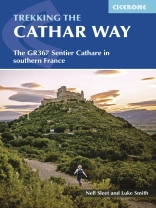Two of the southernmost départements of France, the Pyrénées-Orientales and Ariège are inextricably linked with the history of the Cathars, a heretical Christian sect who were subjected to a crusade in the thirteenth century. Striking castles built on jagged rocky precipices are a highlight of the region and a reminder of those turbulent times. This guidebook describes the 260km Cathar Way (Sentier Cathare or GR367), a long-distance trail from Port-la-Nouvelle on the Mediterranean coast to Ariége’s departmental capital Foix linking several of the impressive Cathar castles. The route follows ancient footpaths, jeep tracks and country lanes and calls for a moderate level of fitness as it sweeps from sea level to 1300m across the rugged hill ranges of the Corbières and Fenouillèdes.
The guide describes the main route in 13 stages and also includes the slightly more direct north variant, as well as suggestions for shorter itineraries. Summary statistics introduce each day’s walking and are followed by step-by-step route description illustrated with clear mapping. There are also details of facilities available en route and accommodation listings. An introduction covers all the practicalities, with comprehensive advice for planning your trip – including when to go, how to get there and what to take – in addition to a wealth of information about the region’s fascinating history and the intriguing Cathars themselves.
The trail traverses rocky hills and meanders through woodland, vineyards, ancient villages, gorges and plateaus. As well as the rich Cathar heritage, there are also historic wine-producing towns, sites associated with the French Resistance of WWII and mysterious places steeped in ancient legend. The guide is a perfect companion to discovering the Cathar Way and the captivating stories of this distinctive region.
Innehållsförteckning
Map key
Overview map
Route summary table
Introduction
Languedoc history
The Cathars and the Crusade
The Cathar Way route
Features of interest
Planning the walk
North variant
Alternative ways to stage the Cathar Way
Getting there
Getting around
When to go
Accommodation
Food and drink
Language
Money matters
Phone and Wi-Fi
Health and safety
What to take
Maps
Waymarking
Updates
Using this guide
The Cathar Way
Port-la-Nouvelle to Puivert
Stage 1 Port-la-Nouvelle to Durban-Corbières
Stage 2 Durban-Corbières to Tuchan
Stage 3 Tuchan to Cucugnan
Stage 4 Cucugnan to Saint-Paul-de-Fenouillet
Stage 5 Saint-Paul-de-Fenouillet to Caudiès-de-Fenouillèdes
Stage 6 Caudiès-de-Fenouillèdes to Axat
Stage 7 Axat to Quirbajou
Stage 8 Quirbajou to Puivert
Cucugnan to Puivert: north variant
Stage 4a Cucugnan to Camps-sur-l’Agly
Stage 5a Camps-sur-l’Agly to Bugarach
Stage 6a Bugarach to Quillan
Stage 7a Quillan to Puivert
Puivert to Foix
Stage 9 Puivert to Espezel
Stage 10 Espezel to Comus
Stage 11 Comus to Montségur
Stage 12 Montségur to Roquefixade
Stage 13 Roquefixade to Foix
Appendix A Villages and towns with amenities
Appendix B Accommodation
Appendix C Useful contacts
Appendix D French-English glossary
Appendix E Further information and reading
Om författaren
Luke and Nell are hikers, travellers and bloggers who detail their slow travel adventures around the world on their blog whatifwewalked.com. Inveterate world backpackers, they started the blog in 2017 when they walked the 2000km Via Francigena from Canterbury in the UK through France, Switzerland and Italy on to Rome.
Since then they have walked extensively in Europe photographing, writing and blogging about trails in Germany, Spain, Portugal, the Faroe Islands, Scotland and much beyond. This is their first guidebook for Cicerone.












